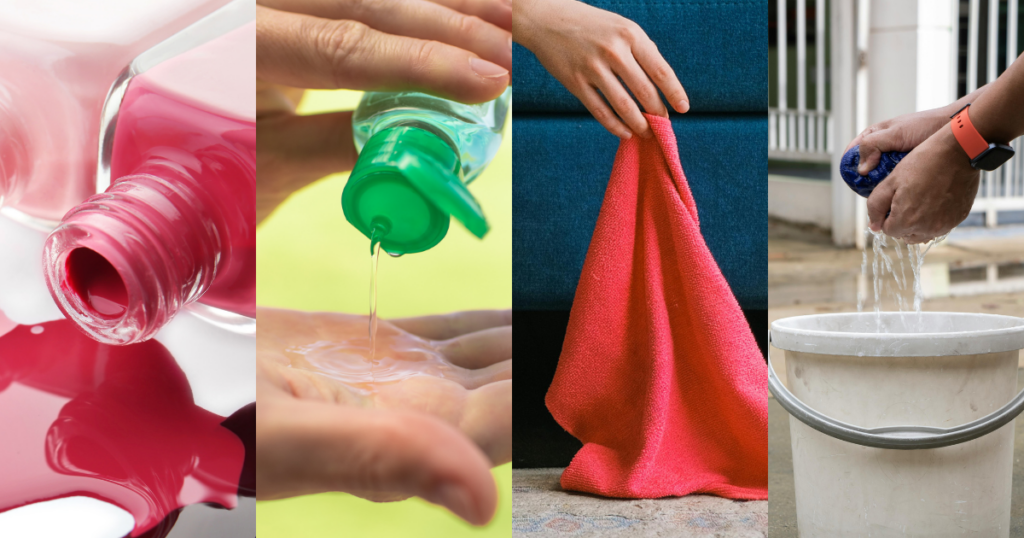Nail polish looks great on fingernails, but when it finds its way onto your carpet, it’s an entirely different story. It’s one of those spills that happens in an instant—often when you’re already running late, painting your nails on the floor, or the kids are playing dress-up in the lounge. One little tip of the bottle, and suddenly you’re left with a bright, sticky stain embedded in the fibres.
So, how do you get nail polish out of carpet? The fastest way is to blot the spill immediately with a clean cloth and apply a safe, effective solution—like non-acetone remover, rubbing alcohol, or a mix of vinegar and baking soda. The key is to act quickly, avoid scrubbing, and always spot-test your cleaning product before applying it more widely.
Whether it’s a fresh spill still wet and glossy, or a hardened stain that’s been hiding under the coffee table for a few days, there’s a solution. You don’t have to cover it up or rearrange your furniture to hide the mess. In this complete guide, we’ll show you how to remove nail polish from flooring safely and effectively, using practical steps that actually work.
Know Before You Start: What NOT to Do When Removing Nail Polish

Before reaching for the nearest chemical or scrubbing brush, take a moment to understand what could make the situation worse. Nail polish stains are stubborn but manageable—unless handled the wrong way.
Here’s what to avoid:
- Don’t scrub. This is a common first instinct, but it only pushes the polish deeper into the fibres and spreads the stain. Instead, always blot gently.
- Avoid using heat. Heat can cause the nail polish to melt and set deeper into the fibres, making it much harder to remove without causing damage.
- Never mix cleaning products. For example, combining bleach and ammonia releases toxic fumes. Always stick to one cleaning agent at a time.
- Don’t skip the spot test. Before treating the visible stain, test your cleaning solution on a hidden patch to avoid discolouration or surface damage.
What You’ll Need: Tools & Cleaning Solutions
Being prepared before you begin makes the process faster and more effective. You don’t need fancy products—just a few basics will do the trick.
Basic Supplies
- Clean, white cloths or absorbent paper towels
- A dull butter knife, spoon, or plastic scraper
- A bowl of warm water
- A soft toothbrush or small scrubbing brush
- Vacuum cleaner
Cleaning Products
- Non-acetone nail polish remover – a gentler alternative to acetone, ideal for sensitive surfaces
- Rubbing alcohol – breaks down polish without discolouring synthetic fibres
- Hairspray – surprisingly effective in loosening polish
- Hydrogen peroxide – best used on light-coloured materials due to its mild bleaching effect
- White vinegar and baking soda – great for natural stain removal
- Dishwashing liquid
- Store-bought stain remover – formulated to target tough marks with minimal effort
- Optional: Dry cleaning solvent – strong but effective for particularly stubborn spots
Step-by-Step: How to Get Wet Nail Polish Out of Carpet

Fresh nail polish is easier to remove, but you’ll need to act quickly. Acting fast prevents the polish from soaking too deep into the fibres. The sooner you begin, the more likely you are to lift the stain completely.
Step 1: Blot, Don’t Rub
Use a dry cloth or paper towel to carefully blot the area. Press lightly to soak up as much of the liquid polish as you can. Avoid rubbing or spreading it around, especially on thick or plush surfaces.
Step 2: Choose Your Cleaning Solution
Pick a cleaning solution that’s safe to use and easy to find around the house. Whether it’s a natural remedy or a store-bought product, the goal is to break down the nail polish without causing any damage to the surface. Always test your chosen solution on a hidden spot first to make sure it doesn’t cause discolouration or affect the material.
Method 1: Non-Acetone Nail Polish Remover
Dab a bit of non-acetone remover onto the stain using a clean cloth or cotton pad. Blot gently to help the remover lift the colour without bleaching the fibres. Repeat the process until you see the stain fading.
Method 2: Rubbing Alcohol
Soak a cloth with rubbing alcohol and press it onto the stained area. This helps break down the nail polish for easier removal. Keep blotting gently until the colour begins to lift from the fibres.
Method 3: Hairspray & Dish Soap Mix
Spray a generous amount of hairspray directly onto the nail polish stain. Let it sit for about 30 seconds to loosen the pigment. Then blot with a mix of dishwashing liquid and warm water.
Method 4: Vinegar and Baking Soda
Cover the stain with baking soda and slowly pour vinegar over it to trigger a fizzing reaction. Let it sit for 10 to 15 minutes to lift the polish. Scrub gently with a soft toothbrush and blot the area clean.
Step 3: Gently Apply the Solution
Use a cloth to dab—not rub—the solution onto the polish stain. Be patient and work in layers to allow the cleaner to do its job. If you’re treating a wool or loop-pile surface, dab with extra care to avoid damaging the weave.
Step 4: Rinse and Dry
Use a clean cloth soaked in warm water to wipe away any leftover solution or residue. Blot the spot dry with a separate towel, pressing gently but firmly. Let the area air dry fully before giving it a vacuum to bring back its original texture.
Step-by-Step: How to Get Dried Nail Polish Out of Carpet

Removing dried nail polish takes more effort, but it can still be done. The polish needs to be softened before it can be lifted properly. With the right products and a bit of patience, you can get the surface looking fresh again.
Step 1: Scrape Off Excess
Gently use a butter knife or plastic scraper to lift any hardened polish. Only remove what comes off easily—don’t force it. This step reduces the amount of product that needs to be broken down later.
Step 2: Soften the Stain
Place a cloth soaked in warm water or rubbing alcohol directly over the stain. Let it sit for a few minutes to break down the dried polish. This helps prepare the stain for easier removal with a cleaning agent.
Step 3: Apply a Cleaning Agent
Use rubbing alcohol, non-acetone remover, or the vinegar and baking soda mix from earlier. Apply the solution gently using a clean cloth or toothbrush. Work it in with a light hand to avoid causing any damage while loosening the stain.
Step 4: Blot and Repeat
Blot the treated area with a fresh, dry towel to lift the loosened polish. You may need to repeat the process a few times, especially for older stains. Continue until the stain disappears or stops improving.
Natural Remedies for Stains (Pet- and Kid-Safe Options)
Sometimes you want to avoid chemicals entirely—especially if you’ve got young children or pets at home. These options are gentler, safer, and still highly effective.
- Vinegar + Baking Soda Paste: Mix into a paste, apply over the stain, let it sit until the fizzing stops, then scrub and rinse.
- Lemon Juice + Dish Soap: Mix lemon juice and dishwashing liquid in warm water. Apply with a cloth, blot dry, and rinse.
- Club Soda Soak: Pour club soda directly over the stain, let it sit, then blot and dry. Works well on surface-level stains.
When to Use Carpet Cleaners or Call a Professional
There are times when no amount of blotting or home remedies will do the trick. If you’ve already tried multiple solutions and the stain is still hanging on—or if the nail polish has seeped deep into the carpet backing—it’s time to escalate. Deep or set-in stains can become permanent if left untreated, and they often require specialised tools and products to fully lift.
Delicate carpet types, like wool, silk blends, or antique rugs, should also be left to the experts. DIY products that work on synthetic carpets can do irreversible damage to more sensitive fibres. When in doubt, it’s always safer to get help than risk ruining your flooring.
If you’re noticing discolouration, a lingering odour, or stiffness in the carpet, we recommend giving us a call. At Right Price Carpet Cleaning, we have the experience, equipment, and know-how to safely treat stubborn stains without damaging your carpet. Our professional team is here to help restore your flooring to its best condition—so you don’t have to stress over a single spill.
Carpet Type Considerations: Treating Different Materials

Understanding your carpet type is key to choosing the right cleaning method and avoiding any long-term damage. Synthetic carpets are generally more durable and can handle alcohol-based solutions like rubbing alcohol or non-acetone nail polish remover. Just be careful not to over-saturate the area, as too much liquid can soak through to the underlay or cause mould if not dried properly.
Wool carpets, on the other hand, are much more delicate. It’s best to stick with gentle, natural remedies such as white vinegar and baking soda. Avoid harsh chemicals like hydrogen peroxide or acetone entirely, as they can permanently damage or discolour the fibres.
When treating light or dark-coloured carpets, always be mindful of the products you’re using. Light carpets may show stains more easily, while darker carpets can be lightened or bleached by strong cleaners like hydrogen peroxide. To be safe, always perform a spot test in an inconspicuous area before treating the main stain.
Aftercare: Revive and Refresh the Carpet
Once the nail polish stain has been removed, it’s important to give your carpet a bit of aftercare to bring it back to its best condition. Start by deodorising the area with baking soda—simply sprinkle it generously over the cleaned spot, leave it for 15 to 20 minutes, and then vacuum thoroughly. This helps eliminate any lingering odours left behind by the cleaning agents or the polish itself.
Next, use a soft brush or wide-tooth comb to lift the carpet fibres. Brushing helps restore the texture and blend the treated area with the rest of the carpet, especially if the fibres were matted down during blotting or scrubbing. If the area still feels stiff or looks dull, consider a quick steam clean to refresh it completely. A short session with a home steam cleaner—or calling in a professional—can help remove any remaining residue and leave the carpet looking uniform and fresh.
Tips on Preventing Spills in the Future

The easiest way to deal with nail polish stains is to avoid them altogether. Always paint your nails on a hard surface like tile, hardwood, or linoleum—never on carpeted floors. Lay down a towel, tray, or protective mat underneath your hands while painting to catch any accidental drips. Make sure nail polish bottles are tightly sealed when not in use and stored away from the floor or high-traffic areas. To prevent tipping, keep your polish in a sturdy container or organiser that stays upright and stable during use and storage.
Quick Fixes for Emergency Spills
If you’ve accidentally spilled nail polish and don’t have your usual cleaning supplies handy, there are a few quick tricks that can help. Dab the stain gently with hand sanitiser—the alcohol content can help loosen the polish until you can clean it properly. If you’re out and about, hairspray can be applied to the spill and blotted quickly with a cloth or tissue to minimise staining. Wet wipes are another handy option in a pinch; use them to dab the edges of the stain and stop it from spreading further into the carpet.
Conclusion: Yes, You Can Save Your Carpet
A nail polish spill might feel like a disaster in the moment—but it’s not the end of your carpet’s story. With the right tools, a steady hand, and a bit of patience, you can clean even the most stubborn polish stains and restore your carpet to its best self.
At Right Price Carpet Cleaning, we’ve seen it all—and we know what works. Whether you’re removing polish, pet stains, or just years of built-up grime, we’re here to help. If your DIY efforts haven’t quite worked out or if you’d rather leave it to the pros, our expert carpet cleaning services are just a call away.
Let us take care of your carpet so you can get back to enjoying your home—stain-free and stress-free.
Frequently Asked Questions
What is the fastest way to get nail polish out of carpet?
The quickest method is to blot the fresh spill immediately, then apply rubbing alcohol or non-acetone nail polish remover using a clean cloth. These products break down the polish fast and are usually safe for most surfaces. Acting fast and avoiding scrubbing is key to stopping the stain from spreading.
Does nail polish remover ruin carpet?
It depends on the type of remover and the material you’re treating. Acetone-based removers can be too harsh and may bleach or damage certain fibres. That’s why we always recommend using a non-acetone version and doing a spot test in a hidden area before applying it widely.
How does vinegar remove nail polish from carpet?
White vinegar, especially when combined with baking soda, works by loosening the bonds in the polish and gently lifting it from the fibres. It’s a milder, non-toxic solution that’s especially handy for light stains or homes with kids and pets. The fizzing reaction helps to break down the polish without the need for harsh chemicals.
Does toothpaste remove nail polish?
In some cases, white toothpaste (not gel) can help soften small polish stains thanks to its gentle abrasives. It’s not the most effective solution on its own but may work on minor spills when nothing else is available. For best results, pair it with a soft brush and rinse thoroughly afterwards.
What’s the best carpet stain remover?
There’s no one-size-fits-all answer—it depends on the type of stain and carpet. For nail polish, we recommend non-acetone remover, rubbing alcohol, or natural options like vinegar and baking soda. If DIY methods aren’t working, a professional-grade carpet cleaner or calling Right Price Carpet Cleaning is the safest way to restore your floors without damage.





Recent Comments